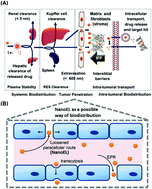Nanoparticles' interactions with vasculature in diseases
Abstract
The ever-growing use of inorganic nanoparticles (NPs) in biomedicine provides an exciting approach to develop novel imaging and drug delivery systems, owing to the ease with which these NPs can be functionalized to cater to various applications. In cancer therapeutics, nanomedicine generally relies on the enhanced permeability and retention (EPR) effect observed in tumour vasculature to deliver anti-cancer drugs across the endothelium. However, such a phenomenon is dependent on the tumour microenvironment and is not consistently observed in all tumour types, thereby limiting drug transport to the tumour site. On the other hand, there is a rise in utilizing inorganic NPs to intentionally induce endothelial leakiness, creating a window of opportunity to control drug delivery across the endothelium. While this active targeting approach creates a similar phenomenon compared to the EPR effect arising from tumour tissues, its drug delivery applications extend beyond cancer therapeutics and into other vascular-related diseases. In this review, we summarize the current findings of the EPR effect and assess its limitations in the context of anti-cancer drug delivery systems. While the EPR effect offers a possible route for drug passage, we further explore alternative uses of NPs to create controllable endothelial leakiness within short exposures, a phenomenon we coined as nanomaterial-induced endothelial leakiness (NanoEL). Furthermore, we discuss the main mechanistic features of the NanoEL effect that make it unique from conventionally established endothelial leakiness in homeostatic and pathologic conditions, as well as examine its potential applicability in vascular-related diseases, particularly cancer. Therefore, this new paradigm changes the way inorganic NPs are currently being used for biomedical applications.



 Please wait while we load your content...
Please wait while we load your content...